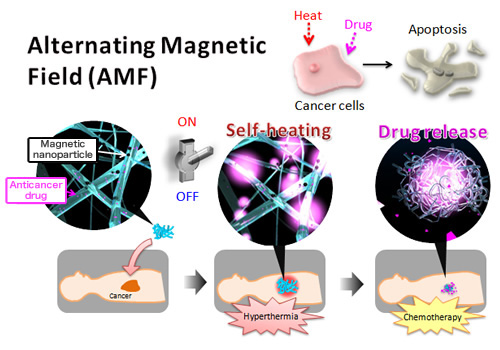- ホーム
- > 研究活動
- > Research Highlights
- > Vol. 7 Smart anticancer nanofibers: S・・・
 Research Highlights
Research Highlights
[Vol. 7]
Smart anticancer nanofibers: Setting treatments to work together
Incorporating magnetic nanoparticles and an anticancer drug into crosslinked polymer nanofibers presents a twofold treatment for fighting cancer with diminished side effects.

Figure 1. Design concept for a smart hyperthermia nanofiber system that uses magnetic nanoparticles (MNPs) dispersed in temperature-responsive polymers. Anticancer drug, doxorubicin (DOX), is also incorporated into the nanofibers. The nanofibers are chemically crosslinked. First, the device signal (alternating magnetic field, AMF) is turned 'on' to activate the MNPs in the nanofi bers. Then, the MNPs generate heat to collapse the polymer networks in the nanofiber, allowing the 'on-off' release of DOX. Both the generated heat and released DOX induce apoptosis of cancer cells by hyperthermic and chemotherapeutic effects, respectively.
Stimuli-responsive or ‘smart’ polymeric nanofibers have attracted increasing attention. The nanoscale structures give rise to high sensitivity to stimuli while they can also be manipulated easily as macroscopic materials. Now researchers at International Center for Materials Nanoarchitectonics (MANA) in Japan have demonstrated how they can be used to host magnetic nanoparticles to exploit hyperthermal effects for treating cancer while avoiding the usual side-effects. The incorporation of doxorubicin in the nanofibers as well allows controlled release of the anticancer drug as an additional mechanism for killing cancer cells.
Magnetic nanoparticles can kill cancer cells through the heat generated by induction when subjected to an alternating magnetic field. Such hyperthermal treatments have also been shown to improve the efficacy of anticancer drugs. However the nanoparticles can also lead to impaired mitochondrial function, inflammation, and DNA damage. Incorporating the nanoparticles into nanofibers may provide a solution.
Young-Jin Kim , Mitsuhiro Ebara , and Takao Aoyagi electrspun the fibers from a solution of the polymer poly(NIPAAm- co -HMAAm) mixed with a solution of magnetic nanoparticles and doxorubicin. The heating caused by the nanoparticles when switching on an alternating magnetic field caused hyperthermal effects, as well as reversible deswelling and deformation of the fibers, which released the drug molecules. Investigations in vitro and in cell lines demonstrated effective killing of cancer cells, which was greatly reduced for hyperthermal treatments alone in the absence of doxorubicin.
As the authors point out “The doxorubicin/magnetic-nanoparticles nanofi ber induced the apoptosis of cancer cells due to a synergistic effect of chemotherapy and hyperthermia.” The work demonstrates how smart nanofibers have potential for use as a manipulative material that combines hyperthermia and drug release treatments that can be controlled with the simple switching on or off of an alternating magnetic field.
Reference
"A smart hyperthermia nanofi ber with switchable drug release for inducing cancer apoptosis"
Young-Jin Kim, Mitsuhiro Ebara, and Takao Aoyagi
Journal : Adv. Funct. Mater 23,46, 5753-5761 (2013)
DOI : 10.1002/adfm.201300746
Young-Jin Kim, Mitsuhiro Ebara, and Takao Aoyagi
Journal : Adv. Funct. Mater 23,46, 5753-5761 (2013)
DOI : 10.1002/adfm.201300746
Affiliations
International Center for Materials Nanoarchitectonics (WPI-MANA), National Institute for Materials Science (NIMS), Namiki 1-1, Tsukuba, Ibaraki 305-0044, Japan
Contact information
ナノアーキテクトニクス材料研究センター(MANA)
〒305-0044 茨城県つくば市並木1-1
TEL: 029-860-4710
E-mail: mana-pr=ml.nims.go.jp([ = ] → [ @ ] )
TEL: 029-860-4710
E-mail: mana-pr=ml.nims.go.jp([ = ] → [ @ ] )

